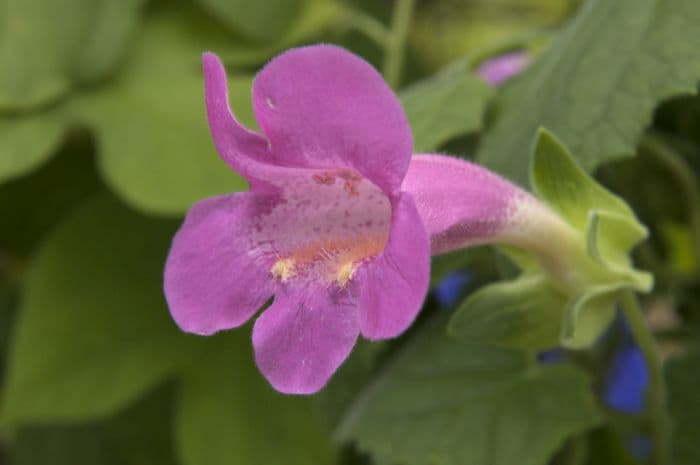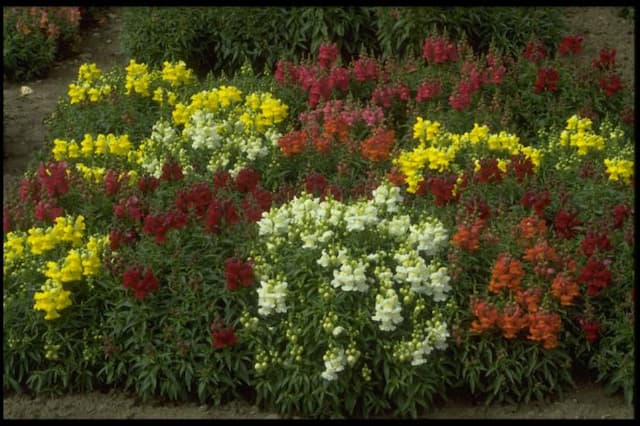Mexican Cardinal Vine Lophospermum erubescens

ABOUT
The common name for Lophospermum erubescens is climbing gloxinia. This plant features a climbing habit, with tendrils that enable it to grip onto supports and structures as it grows. The foliage is comprised of heart-shaped leaves which have a lush green color, providing a dense and verdant backdrop for the flowers. Climbing gloxinia is well-recognized for its remarkable trumpet-shaped flowers that are a major draw for gardeners and flower enthusiasts. These blooms are typically large and showy, displaying shades that range from soft pink to a more striking deep rose, often with a gradient or ombré effect. The flowers boast a velvety texture and are characterized by their flared mouths, which open widely at the ends. The flowers may feature delicate veins or darker throats, providing depth and visual interest. Due to the plant's vining nature, the blossoms are strategically situated along the length of the plant, creating a cascading floral display that can be quite dramatic when the plant is in full bloom. The overall appearance of climbing gloxinia is one of romantic exuberance, with the plant adding a touch of tropical elegance to any space it occupies.
About this plant
 Names
NamesFamily
Plantaginaceae
Synonyms
Creeping Gloxinia, Climbing Snapdragon, Mexican Twining Snapdragon
Common names
Asarina erubescens, Maurandya erubescens.
 Toxicity
ToxicityTo humans
The Lophospermum erubescens, commonly known as the climbing gloxinia, is not widely listed as a toxic plant to humans. However, not all plants have been thoroughly researched for their potential toxicity to humans, and sometimes even non-toxic plants can cause mild stomach upset if ingested. Without definitive information on the toxicity of climbing gloxinia to humans, it is generally advised to avoid consuming any part of this plant. If you suspect poisoning from any plant, seek medical attention promptly.
To pets
The Lophospermum erubescens, commonly known as the climbing gloxinia, does not have a well-documented profile regarding its toxicity to pets such as dogs and cats. Generally, if a plant is not known to be toxic, it does not necessarily mean it is safe for pets to ingest. While there may not be specific symptoms associated with poisoning from climbing gloxinia due to a lack of data, it is advisable to prevent pets from ingesting any part of this plant. If your pet does consume climbing gloxinia and exhibits unusual symptoms, contact a veterinarian.
 Characteristics
CharacteristicsLife cycle
Perennials
Foliage type
Deciduous
Color of leaves
Green
Flower color
Pink
Height
3 feet [0.91 meters]
Spread
3 feet [0.91 meters]
Plant type
Climber
Hardiness zones
9
Native area
Mexico
Benefits
 General Benefits
General Benefits- Aesthetic Appeal: The Mexican Twist plant adds vibrant color and texture to gardens and landscapes with its showy, trumpet-shaped flowers and heart-shaped leaves.
- Attracts Pollinators: Mexican Twist is known to attract hummingbirds, butterflies, and other beneficial pollinators, supporting biodiversity.
- Versatility: Easy to grow in containers, hanging baskets, or as a ground cover, it offers flexibility in garden design and placement.
- Growth Habit: Its climbing and trailing nature makes it an excellent choice for vertical gardening, adding dimension and interest to garden spaces.
- Seasonal Interest: Blooming from early summer to fall, it provides a long season of visual interest in the garden.
- Low Maintenance: Mexican Twist is relatively easy to care for, requiring minimal maintenance once established.
- Drought Tolerance: Once established, it can tolerate periods of low water, making it suitable for gardens in drier climates or water-wise landscaping.
 Medical Properties
Medical PropertiesThis plant is not used for medical purposes.
 Air-purifying Qualities
Air-purifying QualitiesThis plant is not specifically known for air purifying qualities.
 Other Uses
Other Uses- Climber for Vertical Spaces: Lophospermum erubescens, commonly known as creeping gloxinia, can be used to cover vertical structures like trellises, arbors, or fences, providing a natural and aesthetic green curtain.
- Hanging Basket Displays: With its cascading vines, creeping gloxinia is ideal for creating vibrant hanging basket displays that can add color and life to balconies and patios.
- Ground Cover: In suitable climates, it may be used as a lush ground cover in garden beds, helping to suppress weeds and maintain soil moisture.
- Container Gardening: This plant can thrive in containers, making it a versatile option for those with limited garden space or who want to decorate patios and indoor spaces.
- Photography Prop: The attractive flowers of creeping gloxinia can serve as a stunning backdrop or subject for botanical photography.
- Educational Tool: Gardeners and educators can use creeping gloxinia to teach about plant growth habits, pollination, and the care of climbing plants.
- Landscape Architecture: Landscape designers can incorporate creeping gloxinia into garden designs to provide seasonal color and texture.
- Attracting Wildlife: Creeping gloxinia can attract pollinators such as bees and hummingbirds, enhancing the biodiversity of the garden environment.
- Themed Gardens: It can be included in "romantic" or "cottage" garden themes owing to its lush, trailing growth and vibrant trumpet-shaped flowers.
- Theatrical Scenery: For stage productions or photo shoots that require a natural setting, creeping gloxinia vines can contribute to an authentic-looking scene.
Interesting Facts
 Feng Shui
Feng ShuiThe plant Lophospermum erubescens, also known as the Mexican Twist, is not used in Feng Shui practice.
 Zodiac Sign Compitability
Zodiac Sign CompitabilityThe Mexican Twist is not used in astrology practice.
 Plant Symbolism
Plant Symbolism- Love and Affection: Also commonly known as the Mexican climbing trumpet vine, this plant is often associated with love and affection, partly due to its heart-shaped leaves and the way it climbs around structures, symbolizing attachment and connection.
- Vibrancy and Celebration: The bright, trumpet-shaped flowers of Lophospermum erubescens convey a sense of vibrancy and celebration, perhaps because they evoke the lively ambiance of its native Mexico.
- Continuous Growth: The Mexican climbing trumpet vine's rapid growth and expansive vines can symbolize personal or spiritual growth that continues to develop and spread.
- Protection: Given the plant's climbing nature, it can also signify protection, as it creates a natural green cover when used on fences or walls, offering a protective barrier.
 Water
WaterThe creeping gloxinia needs regular watering, especially during the warmer seasons. Water when the top inch of soil feels dry to the touch, typically twice a week, depending on climate conditions. Use room temperature water and apply it directly to the base of the plant, ensuring the soil is evenly moistened but not soggy. Each watering session might require about 16-32 ounces for a medium-sized pot. During winter months, reduce watering frequency to once a week or when the soil is dry several inches deep as the plant's growth slows down.
 Light
LightCreeping gloxinia thrives in bright, indirect light. It is best to place the plant near a window that receives plenty of light but is shielded from the direct rays of the sun, especially during the harsh midday hours. Morning sunlight is beneficial, so an east-facing window is ideal for promoting healthy growth without the risk of leaf burn.
 Temperature
TemperatureCreeping gloxinia prefers a temperature range between 60 and 80 degrees Fahrenheit for optimal growth. The plant should not be exposed to temperatures below 50 degrees Fahrenheit, as cold temperatures can cause damage. Ideally, keep the plant in a consistently warm environment without drastic temperature fluctuations, away from drafty windows and doors during the colder months.
 Pruning
PruningPrune creeping gloxinia to encourage bushier growth and to maintain its shape. Remove any dead or yellowing leaves and spent flowers to promote new growth and flowering. The best time to prune is in the early spring before new growth begins, but light pruning can be done throughout the growing season as needed to keep the plant tidy.
 Cleaning
CleaningAs needed
 Soil
SoilThe ideal soil mix for the Creeping Gloxinia should be well-draining and fertile, with a mix of peat, perlite, and compost. A slightly acidic to neutral pH of 6.0 to 7.0 is suitable for this plant.
 Repotting
RepottingCreeping Gloxinia should be repotted every 1-2 years or when the plant has outgrown its pot, to ensure continued growth and bloom production.
 Humidity & Misting
Humidity & MistingCreeping Gloxinia thrives in moderate to high humidity levels, ideally between 50-70%, to support its lush foliage and beautiful blooms.
 Suitable locations
Suitable locationsIndoor
Place in bright, indirect light and keep soil moist for best indoor growth.
Outdoor
Grow in part shade, protect from strong winds, and keep the soil moist.
Hardiness zone
9-11 USDA
 Life cycle
Life cycleLophospermum erubescens, commonly known as the climbing gloxinia, begins its life cycle as a seed, sown in well-draining soil and requiring consistent moisture and warmth to germinate. The seedlings emerge, typically within 2-3 weeks, growing into young plants that develop a vine structure and can be support-trained to climb. As the plant matures, it develops heart-shaped leaves and, in the right conditions, will start to produce tubular, pink to red flowers, typically during the warmer months. After pollination, which can be assisted by hummingbirds or other pollinators, the flowers give way to capsule-like fruits containing small seeds. The lifecycle can continue if the seeds are collected and sown anew or naturally dispersed. In temperate regions, climbing gloxinia is grown as an annual, and its lifecycle reaches an end with the first frost, but in its native habitat or other suitable climates, it can survive as a perennial, going dormant in colder months and returning the following season.
 Propogation
PropogationPropogation time
Spring-Early Summer
The most popular method of propagation for Lophospermum erubescens, commonly known as creeping gloxinia, is through stem cuttings. This is typically done in the late spring or early summer when the plant is actively growing. The gardener should cut a length of stem about 4 to 6 inches long, ensuring that there are at least a couple of leaves on the cutting. The cut end of the stem should be dipped in rooting hormone powder to encourage root growth and then placed in a well-draining potting mix or directly into the soil. The cutting needs to be kept moist but not overly wet and placed in indirect light until roots have developed, which generally takes a few weeks. Once rooted, the plant can be transplanted to its final location.



![Foxglove [Illumination Ruby Slippers]](/_next/image?url=https%3A%2F%2Fplants-admin.emdemapps.com%2Fimages%2Fplants%2F%2Fimages%2F604b5cbc93f0b.png&w=640&q=75)


![Penstemon [Phoenix Appleblossom]](/_next/image?url=https%3A%2F%2Fplants-admin.emdemapps.com%2Fimages%2Fplants%2F%2Fimages%2F604b553795aab.png&w=640&q=75)

